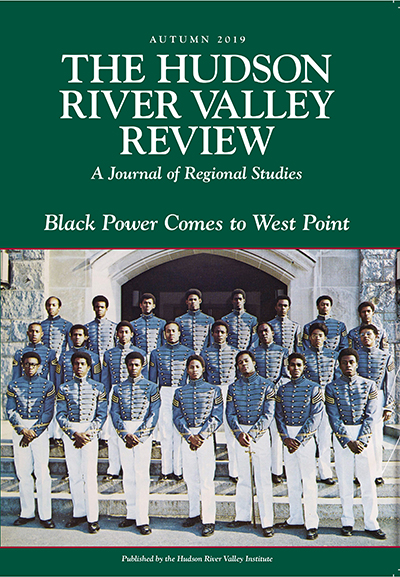From Black Power Cadets at West Point to the Artist Colonies of Woodstock
The latest issue of the Hudson River Valley Review explores the region’s rich history.

In June, The Hudson River Valley Institute held a conference commemorating the fiftieth anniversary of the Woodstock Festival, and the cover article in the current Review was presented there as part of a panel on Civil Rights and Black Power in the 1960s. In this piece, Ty Seidule presents an episode of empowerment for black cadets at the United States Military Academy at West Point, illustrating both the result of the progressive thinking of the 1960s and the ongoing nature of society’s struggle to evolve. Seidule is Professor Emeritus and former Head of the Department of History at West Point.
While the Woodstock Festival eventually landed in the town of Bethel, the organizers named it after the town that had been home to artist colonies since 1902. The Woodstock Artists Association was founded by a diverse group of artists in 1919 and is celebrating its centennial this year. The New York State Museum’s Karen Quinn has written an article on the Arthur C. Anderson Collection that is a useful introduction for anyone unfamiliar with that original cast of artists and colonies; art historian Bruce Weber’s discussion of their “quest for harmony” serves as a reminder that even intentional communities have to work at it.
The artists of the original Woodstock colonies and the musicians and artists who attended the Woodstock Festival had a common love of nature, whether it was plein air painting in the Catskills or dancing in the mud on a Bethel farm. Years before either of them, Alfred B. Street roamed the woods of Sullivan County and wrote about their wonders; Andrew Higgins introduces us to this now-obscure champion of the Catskills and Adirondacks. Likewise, historian Jeanne Haffner introduces Edith Gifford and the role that she and the New Jersey State Federation of Women’s Clubs played in saving the forests of the Palisades and creating the Palisades Interstate Park Commission (PIPC) in 1900. The PIPC went on to create many more parks throughout New York, establishing Highland Lakes State Park in 1970; Spencer Hogan attests to the silent history that remains there under field, forest, and trail.
You can preview the issue and read the Regional History Forum, Book Reviews, and New and Noteworthy Books online at: https://www.hudsonrivervalley.org/back-issues.
The Hudson River Valley Review is available at select booksellers and museum gift-shops throughout the region for $15.00 each. Subscriptions are available through the website at: https://www.hudsonrivervalley.org/subscriptions, or by calling 845-575-3052. A one-year subscription (two issues) is $20.00, save even more by subscribing for two years at $35.00. The Hudson River Valley Institute at Marist College is the center for the study and promotion of the Hudson River Valley, providing information about the region’s history, culture, economy, and environment, and educational resources to teachers, students, and others through www.hudsonrivervalley.org, public programming, and The Hudson River Valley Review. This biannual journal covers all aspects of regional history. All articles in The Hudson River Valley Review undergo peer review.
THE HUDSON RIVER VALLEY REVIEW
Vol. 36, No.1, Autumn 2019
Alfred. B. Street: New York’s Forgotten Nature Poet, Andrew C. Higgins
Women in the Forest: Trees and “Tree Ladies” in the Creation of Palisades Interstate Park, Jeanne Haffner
In Quest of Harmony: The Founding and Early Years of the Woodstock Artists Association, Bruce Weber
Black Power Cadets: How African American Students Defeated President Nixon’s Confederate Monument and Changed West Point, 1971–1976, Ty Seidule
Notes and Documents
The Historic Woodstock Art Colony: The Arthur Anderson Collection, Karen Quinn
Regional History Forum
Highland Lakes State Park: From Settlement to Silence in Under Fifty Years, Spencer Hogan
Plus: Book Reviews and New & Noteworthy Titles Received
About the Hudson River Valley Institute
The Hudson River Valley Institute is a Center of Excellence at Marist College that studies and promotes the history of the Hudson River Valley. The Institute provides information about the region’s culture, economy, environment, and educational resources through www.hudsonrivervalley.org, public programming, and The Hudson River Valley Review. This biannual peer-reviewed journal covers all aspects of regional history.



